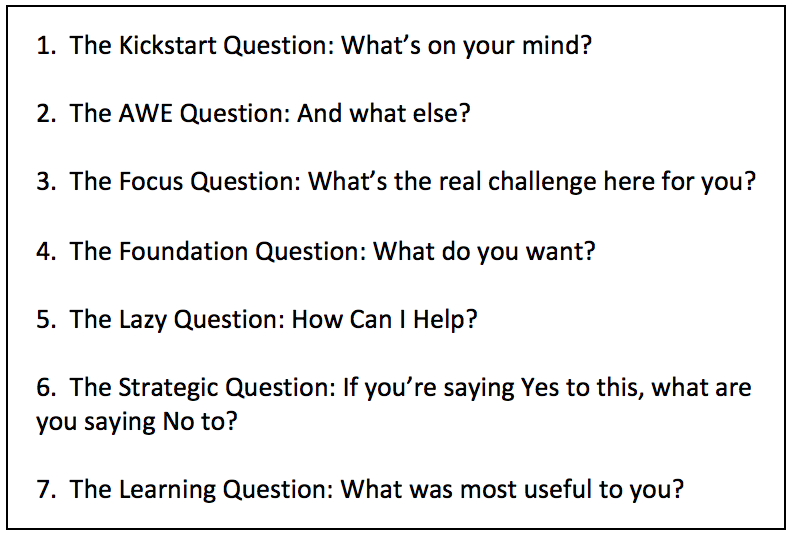 By Cathy Gassenheimer
By Cathy Gassenheimer
Sometimes the title of a book just grabs you. That was certainly the case for me when I came across a new book by Michael Bungay Stanier titled The Coaching Habit: Say Less, Ask More and Change the Way You Lead Forever.
Stanier is the Senior Partner at Box of Crayons, a company that helps organizations “do less Good Work and more Great Work.” A former Rhodes Scholar at Oxford, he’s an Australian transplanted to Canada where he’s been honored as “Canadian Coach of the Year.”
 The book is full of insights for those who coach others. While written with a business audience in mind, Stanier’s observations are quite relevant to educators working as instructional coaches and partners. As an added bonus, it is a quick read, with type that’s easy on the eyes. It also features key quotes in large type throughout the book.
The book is full of insights for those who coach others. While written with a business audience in mind, Stanier’s observations are quite relevant to educators working as instructional coaches and partners. As an added bonus, it is a quick read, with type that’s easy on the eyes. It also features key quotes in large type throughout the book.
The book is organized seven essential coaching questions that Stanier suggests can maximize coaching opportunities. Each of the seven questions has a title ranging from “The Kickstart Question” to “The Learning Question.”
The book also provides useful tips throughout about how to rid yourself of bad coaching habits and how to add good habits related to coaching.
It’s likely that all the suggestions will seem common-sensical to you. But, as the author forewarns, “This stuff is simple, but it’s not easy. It’s hard to change your behavior, and it takes courage to have a go at doing something differently, and, and resilience to keep at it when it doesn’t work perfectly the first time (which it won’t)” (p. 25).
The seven questions are (p. 200):

Stanier adds that there is a certain art to the wording of each question. For example, he explains the precise wording for the “Focus Question,” #3 above:
✻ What’s the challenge? Curiosity is taking you in the right direction, but phrased like this the question is too vague. It will most likely generate either an obvious answer or a somewhat abstract answer (or a combination of the two), neither of which is much help.
✻ What’s the real challenge here? Implied here is that there are a number of challenges to choose from, and you have to find the one that matters most. Phrased like this, the question will always slow people down and make them think more deeply.
✻ What’s the real challenge here for you? It’s too easy for people to pontificate about the high-level or abstract challenges in a situation. The ‘for you’ is what pins the question to the person you’re talking to. It keeps the question personal and makes the person you’re talking to wrestle with her struggle and what she needs to figure out (p. 86).
The book is a very good recap of coaching tips. When reading it, I made connections to the thinking of Edgar Schein, Jim Knight, David Rock, Chris Argyris, to name only a few.
So, if the title resonates with you, and if this short “temptation blog” adds to the appeal, you might want to invest in this new, very readable book.
Cathy Gassenheimer is Executive Vice President for the Alabama Best Practices Center, a division of A+ Education Partnership.

This little book is a treasure trove for anyone in a coaching role. We are planning to use it with our instructional partners next semester in Athens City. I think it would also be a great resource for school administrators or academic or grade level team leaders as well. It’s full of practical information, and the author makes the coaching questions very easy to remember, thus freeing the partner/coach to really listen with intention rather than trying to formulate questions while others speak. My personal favorite question is the “AWE” question–it’s amazing where you can go with just three little words “and what else”. I agree with Cathy– this book is an easy read that connects what we know about best practices for coaches to simple, easy to remember question stems.
Which of the seven questions (in the box above) resonates most with you? Why?
Question #4 Foundation–“What do you want?” urges the educator to “begin with the end in mind” and decide what they want the learner to know and be able to do after the lesson? block? day? This book is my gift to me. Happy Holidays!
This is a phenomenal book that ties to so many of our thought authors. The first three questions alone can be used as a rich coaching conversation script. We bought each IP a book. Here are the posters from our #FCSLearn IP meeting jigsaw:
https://drive.google.com/file/d/0BzpPW61fNF8WcFk3RVpZcWpNb1E/view?usp=sharing
Sorry, this is the link to all 7 posters: https://drive.google.com/drive/folders/0BzpPW61fNF8WZDNTVjI2djNmZFU?usp=sharing